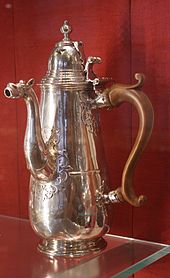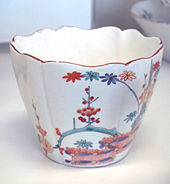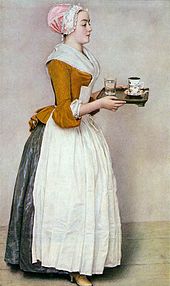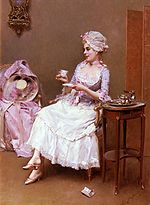- History of chocolate
-
The history of chocolate begins in Mesoamerica. Chocolate, the fermented, roasted, and ground beans of the Theobroma cacao, can be traced to the Mokaya and other pre-Olmec people, with evidence of cacao beverages dating back to 1900 BCE.[1]
Chocolate played a special role in both Maya and Aztec royal and religious events. Priests presented cacao seeds as offerings to the gods and served chocolate drinks during sacred ceremonies. All of the areas that were conquered by the Aztecs that grew cacao beans were ordered to pay them as a tax, or as the Aztecs called it, a "tribute".[2]
The Europeans sweetened and fattened it by adding refined sugar and milk, two ingredients unknown to the Mexicans. By contrast, they never infused it into their general diet, but have compartmentalized its use to sweets and desserts. In the 19th century, Briton John Cadbury developed an emulsification process to make solid chocolate creating the modern chocolate bar.
For hundreds of years, the chocolate making process remained unchanged. When the Industrial Revolution arrived, many changes occurred that brought the hard, sweet candy to life. In the 18th century, mechanical mills were created that squeezed out cocoa butter, which in turn helped to create hard, durable chocolate.[3] But, it was not until the arrival of the Industrial Revolution that these mills were put to bigger use. Not long after the revolution cooled down, companies began advertising this new invention to sell many of the chocolate treats seen today.[4] When new machines were produced, people began experiencing and consuming chocolate worldwide.
Although cocoa is originally from the Americas, today Western Africa produces almost two-thirds of the world's cocoa, with Côte d'Ivoire growing almost half of it.[citation needed]
Contents
Name
The origins of the word "chocolate" probably comes from the Classical Nahuatl word xocolātl (meaning "bitter water"), and entered the English language from Spanish.[5]
How the word "chocolate" came into Spanish is not certain. Perhaps the most cited explanation is that "chocolate" comes from Nahuatl, the language of the Aztecs, from the word "chocolatl", which many sources derived from the Nahuatl word "xocolatl" (pronounced [ ʃoˈkolaːtɬ]) made up from the words "xococ" meaning sour or bitter,[6] and "atl" meaning water or drink.[5]
However, as William Bright noted[7] the word "chocolatl" doesn't occur in central Mexican colonial sources making this an unlikely derivation. Santamaria[8] gives a derivation from the Yucatec Maya word "chokol" meaning hot, and the Nahuatl "atl" meaning water. More recently Dakin and Wichman derive it from another Nahuatl term, "chicolatl" from Eastern Nahuatl meaning "beaten drink".[9] They derive this term from the word for the frothing stick, "chicoli". The word xocoatl means beverage of maize.[10] The words "cacaua atl" mean drink of cacao.[10] The word "xocolatl" does not appear in Molina's dictionary.[10]
Chocolate timeline history
Mesoamerica history
2000 BC, Amazon: Cocoa, from which chocolate is created, is said to have originated in the Amazon at least 4,000 years ago. Cultivation, use, and cultural elaboration of cacao were early and extensive in Mesoamerica. Ceramic vessel with residues from the preparation of cacao beverages have been found at archaeological sites dating back to the Early Formative (1900-900 BC) period. For example, one such vessel found at an Olmec archaeological site on the Gulf Coast of Veracruz, Mexico dates cacao's preparation by pre-Olmec peoples as early as 1750 BC.[1] On the Pacific coast of Chiapas, Mexico, a Mokaya archaeological site provides evidence of cacao beverages dating even earlier, to 1900 BC.[1]
Some anonymous manuscripts describe another way the Aztecs prepared cacao as a beverage. The description of the cocoa drink's preparation process states that, initially, the cocoa beans were ground to powder. During grinding other ingredients (such as seeds or corn) were added. The resulting powder was mixed with cold water and stirred with a spoon until the foam rose by airing the mixture. Sometimes cocoa was prepared not as a beverage, but as a porridge, to which was added cereals such as nixtamalized maize or other ingredients like chili peppers.[11] The Aztecs knew the drink by abbreviations such as cacahoaquahuitl ('tree cacao'), mecacaohatl or tlalcacaoahoatl.[12]
6th century: Chocolate, derived from the seed of the cocoa tree, was used by the Maya Culture, as early as the Sixth Century AD.
300, Maya Culture: To the Mayas, cocoa pods symbolized life and fertility. Stones from their palaces and temples revealed many carved pictures of cocoa pods.
600, Maya Culture: Moving from Central America to the northern portions of South America, the Mayan territory stretched from the Yucatán Peninsula to the Pacific Coast of Guatemala. In the Yucatán, the Mayas cultivated the earliest know cocoa plantations. The cocoa pod was often represented in religious rituals, and the texts their literature refer to cocoa as the god’s food
1200, Aztec Culture: The Aztecs attributed the creation of the cocoa plant to their god Quetzalcoatl who, descended from heaven on a beam of a morning star carrying a cocoa tree stolen from paradise. In both the Mayan and Aztec cultures cocoa was the basis for a thick, cold, unsweetened drink called xocoatl… believed to be a health elixir. Since sugar was unknown to the Aztecs, different spices were used to add flavour, even hot chili peppers and corn meal were used.
15th century, the Aztec empire took over a sizable part of Mesoamerica. The Aztecs traded with Mayans and other people for cacao and often required that citizens and conquered people pay their tribute in cacao seeds — a form of Aztec money. Pueblo people, who lived in an area that is now the U.S. Southwest, imported cacao from Mesoamerican cultures in southern Mexico or Central America between 900 to 1400. This was used in a common beverage consumed by everyone in their society.[13]
Father José de Acosta mentions how he made it in New Spain and Gonzalo Fernandez de Oviedo refers to techniques applied in the Gulf of Nicoya and Chira Island (both in Costa Rica). In them, the "almond toast" was ground and allowed to cook in water until a layer of oil floated (the cocoa butter), which was distributed among the guests. This 'oil' golden yellow, was dyed during milling with a food colouring added to provide a reddish colour to the final beverage. The greasy, dark and bitter drink was an acquired taste in pre-Columbian societies.
1502, Columbus landed in Nicaragua: He was the first European to discover cocoa beans being used as currency, and to make a drink, as in the Aztec culture. Christopher Columbus brought some cocoa beans to show Ferdinand and Isabella of Spain, but it was Spanish friars who introduced it to Europe more broadly.
1513, A slave is bought for beans: Hernando de Oviedo y Valdez, who went to America in 1513 as a member of Pedrarias Avila's expedition, reports that he bought a slave for 100 cocoa beans. According to Hernando de Oviedo y Valdez 10 cocoa beans bought the services of a prostitute, and 4 cocoa beans got you a rabbit for dinner. At this time, the name of the drink changed to Chocolatl from the Mayan word xocoatl [chocolate] and the Aztec word for water, or warm liquid.
1519, Hernando Cortez begins a plantation: Hernando Cortez, who conquered part of Mexico in 1519, had a vision of converting these beans to golden doubloons. While he was fascinated with Aztec's bitter, spicy beverage, he was much intrigued by the beans’ value as currency. Later, Cortez established a cocoa plantation in the name of Spain, henceforth, "money" will be cultivated. It was the birth of what was to be a very profitable business.
Introduction to the outside world
See also: History of chocolate in Spain1528, Chocolate arrives in Spain: Cortèz presented the Spainish King, Charles V with cocoa beans from the New World and the necessary tools for its preparation. Cortez later inspires a major breakthough: He postulated that if this bitter beverage were blended with sugar, it could become quite a delicacy. The Spaniards mixed the beans with sugar, vanilla, nutmeg, cloves, allspice and cinnamon. The results were tantalizing, coveted, fashionable, and reserved for the Spanish nobility which created a demand for the fruits of his Spanish plantations. Chocolate was a secret that Spain managed to keep from the rest of the world for almost 100 years.
1569, Pope Pius V, who did not like chocolate, declared that drinking chocolate on Friday did not break the fast.
 Silver chocolate pot with hinged finial to insert a molinet or swizzle stick. London 1714-15 (Victoria and Albert Museum)
Silver chocolate pot with hinged finial to insert a molinet or swizzle stick. London 1714-15 (Victoria and Albert Museum)
1585, The first shipment of beans intended for the market make it to Spain.
1609, The first book devoted entirely to chocolate, Libro en el cual se trata del chocolate, came from Mexico.
1615, Ann of Austria, daughter of Philip III from Spain, introduced the beverage to her new husband, Louis the XIII, and his French court, too.
 Chocolate cup, Chantilly porcelain, 18th century.
Chocolate cup, Chantilly porcelain, 18th century.
1643, The French Court Embraces Chocolate: When the Spanish Princess Maria Theresa was betrothed to Louis XIV of France, she gave her fiancé an engagement gift of chocolate, packaged in an elegantly ornate chest.
1650, The chocolate craze which now included candy took hold in Paris and then conquered the rest of France. Chocolate’s reputation as an aphrodisiac flourished in the French courts. Art and literature was thick with erotic imagery inspired by chocolate.
1657, The first chocolate house opened in London in 1657.[14] In 1689, noted physician and collector Hans Sloane developed a milk chocolate drink in Jamaica which was initially used by apothecaries, but later sold to the Cadbury brothers.[15] London chocolate houses became the trendy meeting places where the elite London society savoured their new luxury. The first chocolate house opened in London advertising "this excellent West India drink."
1674, An avant garde, London coffee house goes down in the annals of history for serving chocolate in cakes and also in rolls.
1677, November 1, Brazil, later to achieve an important position in the world market, establishes its first cocoa plantations.
1704, Chocolate makes its appearance in Germany, and Frederick I of Prussia reacts by imposing a tax.
1711, Chocolate migrates to Vienna: Emperor Charles VI transfers his court from Madrid to Vienna and along with his Court, comes chocolate.
1730, The transition was hastened by the advent of a perfected steam engine, which mechanized the cocoa grinding process. By 1730, chocolate had dropped in price from three dollars or more per pound to within financial reach of all.
 Chocolate Girl by Jean-Étienne Liotard, circa 1743-45
Chocolate Girl by Jean-Étienne Liotard, circa 1743-45
1755, Chocolate makes its appearance in The United States.
1765, First chocolate factory in the USA: The production of chocolate proceeded at a faster pace than anywhere else in the world. It was in pre-Revolutionary New England.
1780, The first machine-made chocolate is produced in Barcelona.
1792, In Germany, the Josty brothers from Grisons open a open a chocolate factory in Berlin.
1810, A survey shows that Venezuela produces half of the world's chocolate. And 1/3 is consumed by the Spaniards.
1819, As cocoa plantations spread to the tropics in both hemispheres by the 19th century, the increased production lowered the price of the cocoa beans and chocolate became a popular and affordable beverage.
1828, The cocoa press is invented: The press lead to reduced prices and helped to improve the quality of the beverage by squeezing out part of the cocoa butter. Drinking chocolate had a smooth consistency and a more pleasing taste.
1830, The drink became a confection: Solid eating chocolate was developed by J. S. Fry & Sons, a British chocolate maker.
1849, Cadbury brothers exhibited chocolate: The exhibition was at Bingley Hall at Birmingham, England.
1851, Was the first time citizens of the United States were introduced to bonbons, chocolate creams, hard candies (called "boiled sweets") and caramels.
1875, Milk chocolate comes of age: After eight years of experimentation, Daniel Peter from Switzerland puts the first milk chocolate on the market.
1879, Rodolphe Lindt of Berne, Switzerland, invented "conching", a means of heating and rolling chocolate to refine it. After chocolate has been conched for 72 hours and has more cocoa butter added to it, chocolate becomes "fondant" and thus it melts in the mouth.
1900, Switzerland takes the leadership role: Spain, where chocolate was first introduced to Europeans, falls far behind. Germany consumes the most per head, followed by the United States, France and Great Britain.
1913, Jules Sechaud of Montreux of Switzerland introduced the process for filling chocolates.
1923, The CMA was Established: The Chocolate Manufacturers Association of the United States of America (CMA) was organized in.
1938, World War II: The U.S. government recognized chocolate's role in the Allied Armed Forces. It allocated valuable shipping space for the importation of cocoa beans which would give many weary soldiers the strength to carry. Today, the U.S. Army D-rations include three 4-ounce chocolate bars. Chocolate has even been taken into space as part of the diet of U.S. astronauts.
See also
- Words of Nahuatl origin
- Alonso de Molina's dictionary of 1571 and of 1555
- History of yerba mate
References
- ^ a b c Terry G. Powis, W. Jeffrey Hurst, María del Carmen Rodríguez, Ponciano Ortíz C., Michael Blake, David Cheetham, Michael D. Coe & John G. Hodgson (December 2007). "Oldest chocolate in the New World". Antiquity 81 (314). ISSN 0003-598X. http://antiquity.ac.uk/projgall/powis/index.html. Retrieved 15 February 2011.
- ^ Justin Kerr. "Chocolate: A Mesoamerican Luxury 1200—1521 - Obtaining Cacao". Field Museum. http://archive.fieldmuseum.org/chocolate/history_mesoamerican7.html. Retrieved 23 November 2011.
- ^ Justin Kerr. "Chocolate: A Contemporary Confection 1750—1910 - Making Chocolate". Field Museum. http://archive.fieldmuseum.org/Chocolate/history_contemp4.html. Retrieved 23 November 2011.
- ^ Justin Kerr. "Chocolate: A Contemporary Confection 1750—1910 - Using Chocolate". Field Museum. http://archive.fieldmuseum.org/chocolate/history_contemp5.html. Retrieved 23 November 2011.
- ^ a b "The American Heritage Dictionary". http://www.bartleby.com/61/68/C0316800.html. Retrieved 09 May 2009.[dead link]
- ^ This "bitter" is translation from "agrio" in Spanish. It is a paraphrase for "acid". "Bitter" for chocolate is "amargo" in Spanish. See also :"Confusion in the use of the taste adjectives ‘sour’ and ‘bitter’"(Oxford Journals)
- ^ Campbell, Lyle. Quichean Linguistic Prehistory; University of California Publications in Linguistics No. 81. Berkeley, California: University of California Press. pp. 104.
- ^ Santamaria, Francisco. Diccionario de Mejicanismos. Mexico: Editorial Porrúa S. A.. pp. 412–413.
- ^ Dakin, Karen; Wichmann, Soren (2000). "Cacao and Chocolate A Uto-Aztecan perspective". Ancient Mesoamerica (Cambridge: Cambridge University Press) 11 (1): 55–75. doi:10.1017/S0956536100111058.
- ^ a b c Molina, Fray Alonso de (1977). Vocabulario en Lengua Castellana y Mexicana y Mexicana y Castellana. Edicion Facsimile. Mexico: Editorial Porrua, S.A.. pp. 10.
- ^ Bogin, B. (1997), The evolution of human nutrition. The Anthropology of Medicine: From Culture to Method, Romanucci-Ross, L., Moerman, D. E. & Tancredi, L. R eds., Bergin and Garvey, Westport, CT, pp. 98–142
- ^ Bernardino de Sahagún, (1585), Historia general de las cosas de la Nueva España, Book 11, chapter 6, paragraph 7.
- ^ http://www.sciencenews.org/view/generic/id/71308/title/Pueblo_traded_for_chocolate_big-time
- ^ Justin Kerr. "Chocolate: A European Sweet - 1600-1750 - Using Chocolate". Field Museum. http://archive.fieldmuseum.org/Chocolate/history_european10.html. Retrieved 23 November 2011.
- ^ "About Hans Sloane". Natural History Museum. http://www.nhm.ac.uk/research-curation/projects/sloane-herbarium/hanssloane.htm. Retrieved 08 June 2007.
External links
- Gutenberg’s “Chocolate: or, An Indian Drinke”
- LibriVox’s Audio Book “Chocolate: or, An Indian Drinke”
- The Chocolate and Ancient Maya
- A Brief History of Chocolate -- Smithsonian.com
- Chocolate: Food of the Gods Cornell University, Mann Library
- The history of chocolate
- Traité du chocolat
Chocolate Background - Outline of chocolate
- History of chocolate
- Health effects of chocolate
- History of chocolate in Spain

Origins Varieties Chemicals See also Categories:- Chocolate
- History of food and drink
- Native American cuisine
Wikimedia Foundation. 2010.


